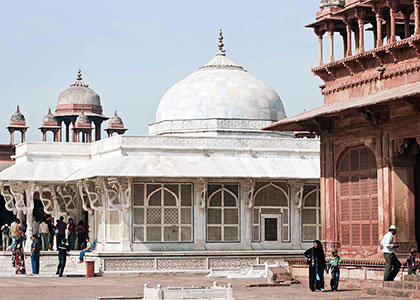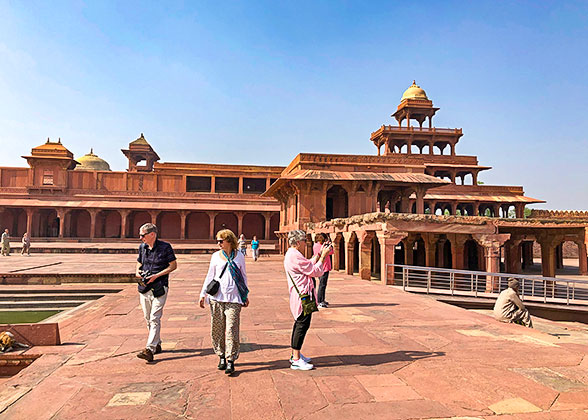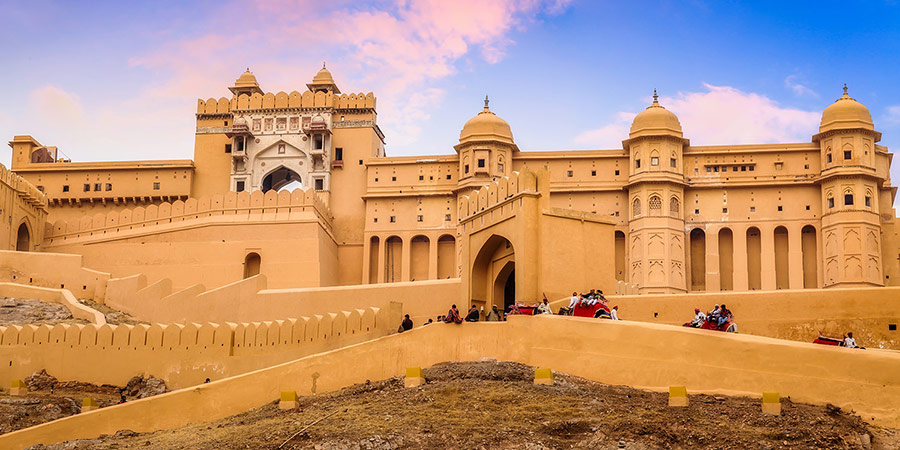The Tomb of Salim Chishti – A Magnificent Marble Structure
Mughal Empire was one of the glorious dynasties of South-East Asia. Founded in the 16th century by Babar, a warrior chief from Uzbekistan, the empire lasted close to four centuries. These rulers introduced several political reforms during their reign, built stunning UNESCO World Heritage Sites and one of the Seven Wonders of the World, were excellent warriors and diplomats, and revolutionized the Indian gastronomy.Apart from that, most Mughal rulers were tolerant of other religions and were some of the great patrons of art and culture. However, Akbar is often considered the most religiously open-minded ruler among the lot. Being an excellent statesman and military chief, he expanded the boundaries of the Mughal Empire while encouraging local art and culture to grow at the same time.
Under his rule, the Mughal Empire entered its golden era. He commissioned buildings and palaces that held showcased the architectural and engineering marvels of India. Fatehpur Sikri complex and the tomb of Salim Chishti are fine examples.
Introduction to Fatehpur Sikri
Fatehpur Sikri is a fortified city overlooking a rocky ridge, which served as the capital of the Mughal Empire from 1571 to 1585. Close to Agra, the stunning citadel has been a popular landmark on the itinerary of tourists. The glorious monument was carefully crafted and built with artistic precisions but was left completely abandoned after the death of Akbar. Several reasons, including scarcity of water, contributed towards its abandonment.
|
|
A beautiful blend of Indo-Islamic architecture, the Fatehpur Sikri is a dynamic imperial citadel surrounded by palaces and gardens. Some of the most stunning complexes inside Fatehpur Sikri include the tomb of Salim Chishti, Diwan-E-Khas (Hall of Private Audiences), Panch Mahal (Five-level Palace), Khwabgah (Dream House), Ibadat Khana (Prayer Hall), and Pachisi Courtyard.
However, among these stunning complexes and palaces, the Jama Masjid and the tomb of Salim Chishti are probably the most beautiful structures. Built with stunning white marbles and decorated with mother of pearls, these complexes are still visited by followers of Salim Chisti and his school of Sufism.
The Prophecy and the King
According to several historical records, Akbar once visited the Salim Chisti, a Sufi saint and the follower of Khwaja Moinuddin Chishti of Ajmer. The king, till then childless, was assured by the saint that heirs would be born to expand the Mughal lineage. After king’s oldest son, Salim (later known as Emperor Jahangir) was born Akbar began building a religious compound and the tomb of Salim Chishti in the honor of the saint. Later on, a fortified city – Fatehpur Sikri – was built around the compound.The Architectural Plan of the Tomb of Salim Chishti
Located on the Sahn courtyard (central courtyard) of the Jama Masjid, the tomb of Salim Chishti is probably among the finest examples of Indo-Persian architecture. According to historical records, the construction of the tomb was completed around the late 16th century. The white marble edifice is decorated with stunning latticework and colorful mosaic.While entering the tomb, visitors have to cross massive doors of ebony. The interior of the tomb is decorated with stunning colorful murals. Inside lies the wooden canopy made from sandalwood and adorned with mother-of-pearl shells. A passage for circumambulation, encircling the tomb, is often used by visitors who want to pay respect to the saint.
Close to the tomb of Salim Chishti, lie the graves of the male descendants of the saint. Among them, the most important and heavily decorated grave belongs to Shaikh Badruddin Chisti (grandson of the saint).
Important Pavilion of Fatehpur Sikri
Apart from the tomb of Salim Chishti, visitors can explore the different pavilions and palaces built inside the citadel. Some of the important complexes include:· Diwan-E-Am (Hall of Public Audiences)
The hall was used for hosting public hearing and sessions. The building has a Jharokha (elevated platform) known as Takht-E-Murassa meant for the king. Surrounded by well-manicured gardens, the Diwan-i-Am is a stunning building.· Diwan-E-Khas (Hall of Private Audiences)
Similar to Diwan-E-Am, this building was also used by the emperor for a private audience. According to several historical records, these pavilions were used for discussing delicate matters of the state. On some occasions, Akbar has been known to organize theological and philosophical debates. The exterior of the building is quite simple. However, the interior is decorated with beautifully crafted pillars.· Panch Mahal (The Entertainment Hall)
The five-storied building, at first glance, reminds visitors of a Buddhist temple. The columnar structure, with multiple receding floors, topped one after another, was used for recreation and entertainment purposes. Close to Zenana, the complex was used by the imperial women for recreational purposes.· Khwabgah (The abode of dream)
One of the most stunning complexes of Fatehpur Sikri after the tomb of Salim Chishti, it was Akbar’s palace. The complex opens up to the royal Zenana (Harem) on one side and Panch Mahal on the other side, making it easier for the emperor to move from one quarter to others. The personal space of the king is regally decorated with stunning carvings and murals inspired by the local motifs.Things to Remember While Visiting Fatehpur Sikri
Fatehpur Sikri is one of the popular tourist destinations of Agra. Once a thriving capital city, the citadel was completely abandoned in the early 17th century. However, it offers some of the fine examples of Mughal architecture and engineering. However, there are certain things to remember for planning a hassle-free trip:
![]() Best time visit: October to February
Best time visit: October to February
![]() Reaching Fatehpur Sikri: Buses and private cabs from Agra are available, visitors can park their cars at Agra Gate (approximately one kilometer away from the main structure) – government shuttles are available to cover the distance between parking space and main structure
Reaching Fatehpur Sikri: Buses and private cabs from Agra are available, visitors can park their cars at Agra Gate (approximately one kilometer away from the main structure) – government shuttles are available to cover the distance between parking space and main structure
![]() Guides: One can hire licensed guides from the ticket counter close to Diwan-e-Am gate
Guides: One can hire licensed guides from the ticket counter close to Diwan-e-Am gate






